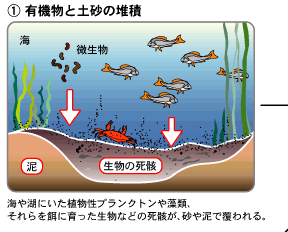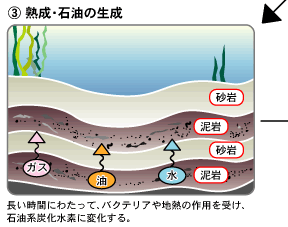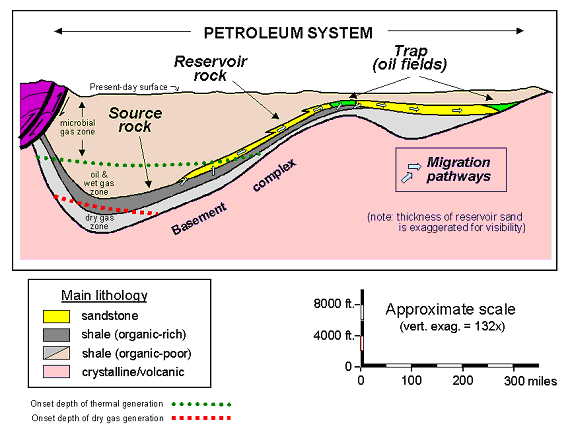/Image359.gif) 図K2 ケロジェンおよび石炭マセラルのタイプ: タイプI~IIIケロジェンが示されている。縦軸が水素/炭素比(H/C),横軸が酸素/炭素比(O/C)で,van Krevelen図という。H/C,O/Cが高いほど熟成度が低い。石炭の場合は、その端成分の種類で判別されている。水生藻類由来のalginite,植物の表皮や胞子などから形成されるexinite,木質のvitriniteで表現されている(Vandenbroucke and Largeau, 2007引用)。 北大・理・生物地球化学研究室(HP/2011/5)による『生物・高分子地球化学トピックス』による |
/Image358.gif) Monash University(HP/2011/5)の中のBeardsmore & Cull(2001)による『Crustal Heat Flow: A Guide to Measurement and Modelling』の『Chapter 5: Thermal Maturity』から |
/Image355.gif) |
/Image356.gif) |
/Image357.gif) |
|
| non reagent nisi soluti(HP/2011/5)による『Evolusi termal material organik (2)』から | |
/Image354.gif) Evolution of kerogen. A modified Van Krevelen diagram shows changes to kerogen brought on by increased heat during burial. The general trend in the thermal transformation of kerogen to hydrocarbon is characterized by the generation of nonhydrocarbon gases, and then progresses to oil, wet gas, and dry gas. Type IV is residual kerogen considered to be primarily dead carbon or inertinite that does not generate hydrocarbon. |
The naturally occurring, solid, insoluble organic matter that occurs in source rocks and can yield oil upon heating. Kerogen is the portion of naturally occurring organic matter that is nonextractable using organic solvents. Typical organic constituents of kerogen are algae and woody plant material. Kerogens have a high molecular weight relative to bitumen, or soluble organic matter. Bitumen forms from kerogen during petroleum generation. Kerogens are described as Type I, consisting of mainly algal and amorphous (but presumably algal) kerogen and highly likely to generate oil; Type II, mixed terrestrial and marine source material that can generate waxy oil; and Type III, woody terrestrial source material that typically generates gas. |
|
Schlumberger(HP/2011/5)による『Oilfield Glossary』の中の『Kerogen』から ※縦軸はH/C原子比で、横軸はO/C原子比。タイプⅠがケロジェンから典型的な石油への変化経路。 |
|
/Image1422.gif)
/Image432.gif)





/Image373.gif)
/Image370.gif)
/Image369.gif)
/Image1184.gif)
/Image1185.gif)
/Image371.gif)
/Image368.gif)
/Image372.gif)
/Image1423.gif)